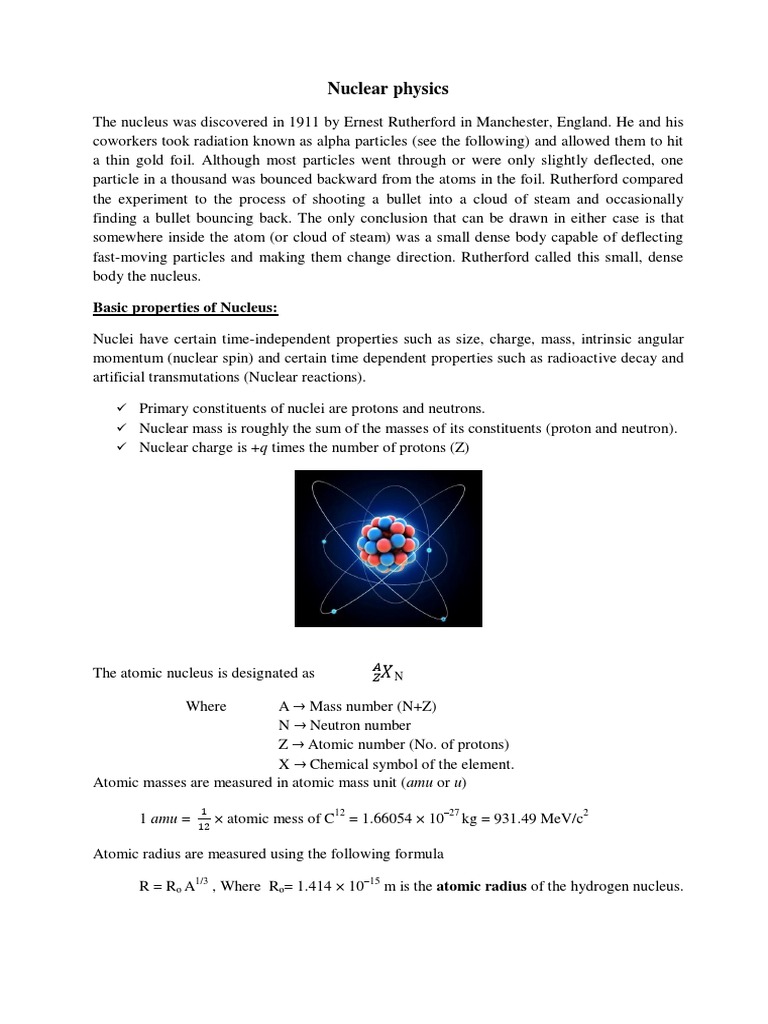Nuclear physics, an intricate tapestry interwoven with the essence of matter itself, unveils the fundamental particles that construct the nuclei of atoms—the very building blocks of the universe. To comprehend what constitutes a nucleus, one must delve deep into the subatomic realm, where protons and neutrons dance in an unyielding bond, resembling a cosmic ballet governed by the forces of nature. This exploration will not only illuminate the characteristics of nuclei but will also reveal their pivotal role in the grand narrative of existence.
At the core of nuclear physics lies the nucleus—an entity defined as the central part of an atom, encompassing protons and neutrons, termed collectively as nucleons. Imagine the nucleus as the heart of a solar system, where protons, positively charged particles, serve as the sun, radiating a force that holds everything together. Meanwhile, neutrons act like distant planets, neutral in charge yet possessing significant mass that contributes to the gravitational pull of the nucleus. The interaction among these particles is a testament to the fundamental forces at play, particularly the strong nuclear force, which counteracts the electromagnetic repulsion between protons, ensuring stability within this tight-knit assembly.
The architectural design of a nucleus is remarkably intricate. Each nucleus is characterized by its atomic number, indicative of the number of protons it contains, which defines the elemental identity. For instance, hydrogen, the simplest element, harbors a mere one proton, while uranium, a heavier element, encompasses 92 protons. Intriguingly, the number of neutrons can fluctuate, resulting in various isotopes of an element. These isotopes, akin to different genres of music, maintain the same fundamental essence yet give rise to distinct characteristics, such as variations in nuclear stability and radioactivity. The interplay between protons and neutrons thus attests to the delicate balance of forces that govern atomic behavior.
Beyond their structural complexity, nuclei exhibit remarkable properties that extend far beyond mass and charge. The concept of binding energy emerges as a crucial determinant of nuclear stability, a metaphorical glue that holds the nucleons together. This energy, derived from the strong nuclear force, varies significantly among different nuclei, determining their resilience against decay. A captivating aspect is the binding energy curve, which reveals that elements with atomic mass numbers around iron exhibit the highest stability, akin to celestial bodies effortlessly maintaining their trajectories amidst cosmic chaos. Conversely, lighter and heavier elements alike are prone to instability, often resulting in several decay modes—alpha, beta, and gamma decay—transforming these elements into new entities and reshaping the landscape of matter.
The phenomenon of radioactivity, intimately tied to the existence of nuclei, further emphasizes their enigmatic nature. When a nucleus is unstable, it may undergo transformations that yield particles or electromagnetic radiation. Alpha decay involves the ejection of helium nuclei, while beta decay results from the conversion of neutrons into protons (or vice versa), often through the emission of electrons or positrons. Such processes not only play a crucial role in the natural transmutation of elements but also serve as the underpinnings of various applications, from medical imaging through radiotracers to the harnessing of nuclear energy for electricity. This dualistic nature of nuclei—both creators and destroyers—catalyzes ongoing research and technological advancements.
Moreover, the discovery of the strong nuclear force, described by quantum chromodynamics (QCD), unveils a deeper narrative within the underlying constituents of nucleons. Quarks—subatomic entities that combine to form protons and neutrons—engage in a vibrant interaction orchestrated through the exchange of particles known as gluons. This symphony of forces and particles underscores the complexity of nuclear interactions and reflects the philosophical notion that at the heart of existence lies an interconnected web of relationships dictated by fundamental forces.
Nuclear structure extends beyond mere composition and energy; it encompasses the fascinating behavior of nuclei under extreme conditions. The rare and ephemeral state known as the nuclear liquid drop model suggests that nuclei behave similarly to droplets of liquid, exhibiting surface tension and volume effects. When subjected to high-energy collisions, such as in particle accelerators, the nuclei can undergo fusion—a process wherein two light nuclei merge, releasing vast amounts of energy in the form of radiation. This phenomenon echoes the luminosity of a stellar birth, as the energies resemble those found in the interiors of stars, where such processes forge heavier elements through nucleosynthesis.
Exploring the intricacies of nuclear decay has led to diverse applications in fields such as medicine and environmental science. Radiotherapy employs specific isotopes to target and obliterate cancer cells while leaving surrounding tissue relatively unscathed—a testament to the sensitive balance of destructive and constructive forces. Moreover, the study of radioactive isotopes provides insights into environmental processes, age determination of ancient artifacts, and understanding nuclear reactions occurring within stars, thereby bridging the gap between the microscopic and macroscopic world.
In conclusion, the study of nuclei within nuclear physics transcends the mere exploration of particles and forces; it ventures into the fundamental questions of existence. By deciphering the complexities of nuclei, one not only gains insight into the forces that bind matter but also uncovers the intricate interplay between decay and creation—a metaphorical dance that echoes through the annals of time and space. As humanity continues to push the boundaries of scientific inquiry, the compelling narrative of nuclei will undoubtedly inspire future generations to explore the profound mysteries of the universe.












